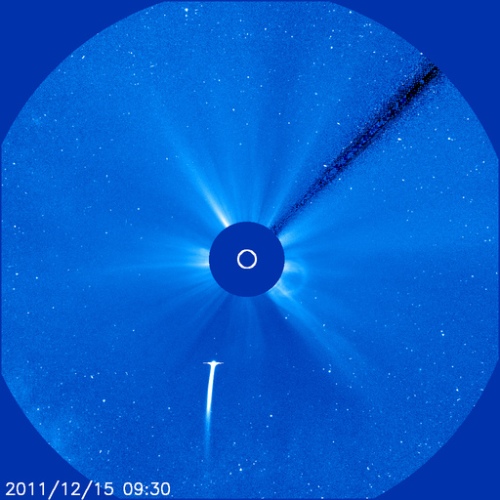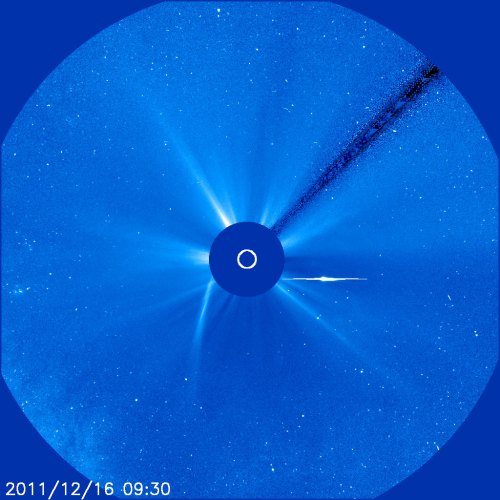On the night of November 27th 2011 amateur astronomer and comet hunter Terry Lovejoy from Australia discovered something that he marked as “probable reflection” with his telescope. He checked back and it wasn’t a reflection at all, it was a comet. This comet named after his discoverer C/2011 W3 Lovejoy belongs to what is known as the “Kreutz Sungrazers” family, comets with orbits bringing them really close to the sun, the theory is that these comets are fragments of a larger comet that was fragmented thousands of years ago.
Comet Lovejoy started then a journey of amazing highlights for the astronomical community. It’s the first comet of the Kreutz group to be discovered from the ground in 30 years, usually they are discovered using NASA’s solar telescopes such as SOHO or STEREO. After initial calculations the comet body was estimated to be as big as a football field, not enough to survive a close approach to the Sun. Comet Lovejoy was doomed.

Lovejoy Approaching the Sun
While approaching the Sun Lovejoy brightened to magnitude -4, that’s as bright as planet Venus making it the third brightest object in the sky after the Sun and the Moon. It wasn’t visible to the naked eye because the comet was too close to the Sun, lost in the glare. This was supposed to be all, after perihelion the little comet would be destroyed into tiny fragments never to be seen again.
But comets are like a box of chocolate, you never know what you are gonna get. The astronomy world was amazed when the comet emerged from behind the Sun.

It's Alive!
The comet emerged from behind the Sun and looked smaller and had lost its tail. It was a miracle for the little comet to have survived perihelion but that was only a small thing compared to what was coming. The comet re-formed it’s tail and brightened and now astronomers started to discuss the possibility of the comet being visible to the naked eye.
Due to its orbit Lovejoy is only visible to observers in the south hemisphere it started very close to the sun so astronomers and photographers had to hunt for it a few minutes before dawn, as soon as it cleared some degrees away from the Sun the show started.
The comet became visible to the naked eye before dawn, it was easy to see on December 23rd, I went to a rural location and at around 3am the tail of the comet rose from behind the trees at the horizon, it was a fantastic sight. It quickly brightened and its two tails were easy to spot with the naked eye and magnificent in photos.
The main tail curves above the horizon and is made of dust, the secondary tail is made of ionized gas and rises straight from the horizon. As said before both tails were easy to see with the naked eye.
As photos started to come from Australia, South Africa and Argentina the comet became bigger and brighter, people compared it with comet McNaught from 2007 and with Ikeya-Seki from 1965, the brightest comet in the history of mankind and also a member of the Kreutz family. Lovejoy wasn’t that bright, you had to go to rural areas to see it but it was really big with its tail extending for more than 20 degrees.
There is no formal definition of “great comet” but in some places they say that a comet needs to be bigger than 15 degrees and visible to the naked eye. If we take that definition then Lovejoy is without a doubt the great comet of 2011. It’s huge and bright enough to be an easy naked eye object from rural areas. In my estimations it was brighter than the Milky Way and as bright as the Magellan Clouds but the clouds were very high in the sky and the comet close to the horizon so it’s probably brighter.
Lovejoy will now begin to travel fast away from the Sun towards the south celestial pole. It will be fainter each day and it will be higher in the skies of the south hemisphere. By January 8th the comet will be circumpolar at latitude 35 degrees south, that means it will be visible the whole night. It will not be visible by the naked eye but with binoculars or telescopes it promises to keep being a fantastic target.
This comet, discovered by an amateur astronomer, was supposed to be destroyed at perihelion it survived and displayed a fantastic show. It was a great christmas gift for all the people that like the beauties and surprises of the night sky.
You can find my photos of Comet Lovejoy at the special gallery I created on my website: http://www.luisargerich.com/lovejoy




